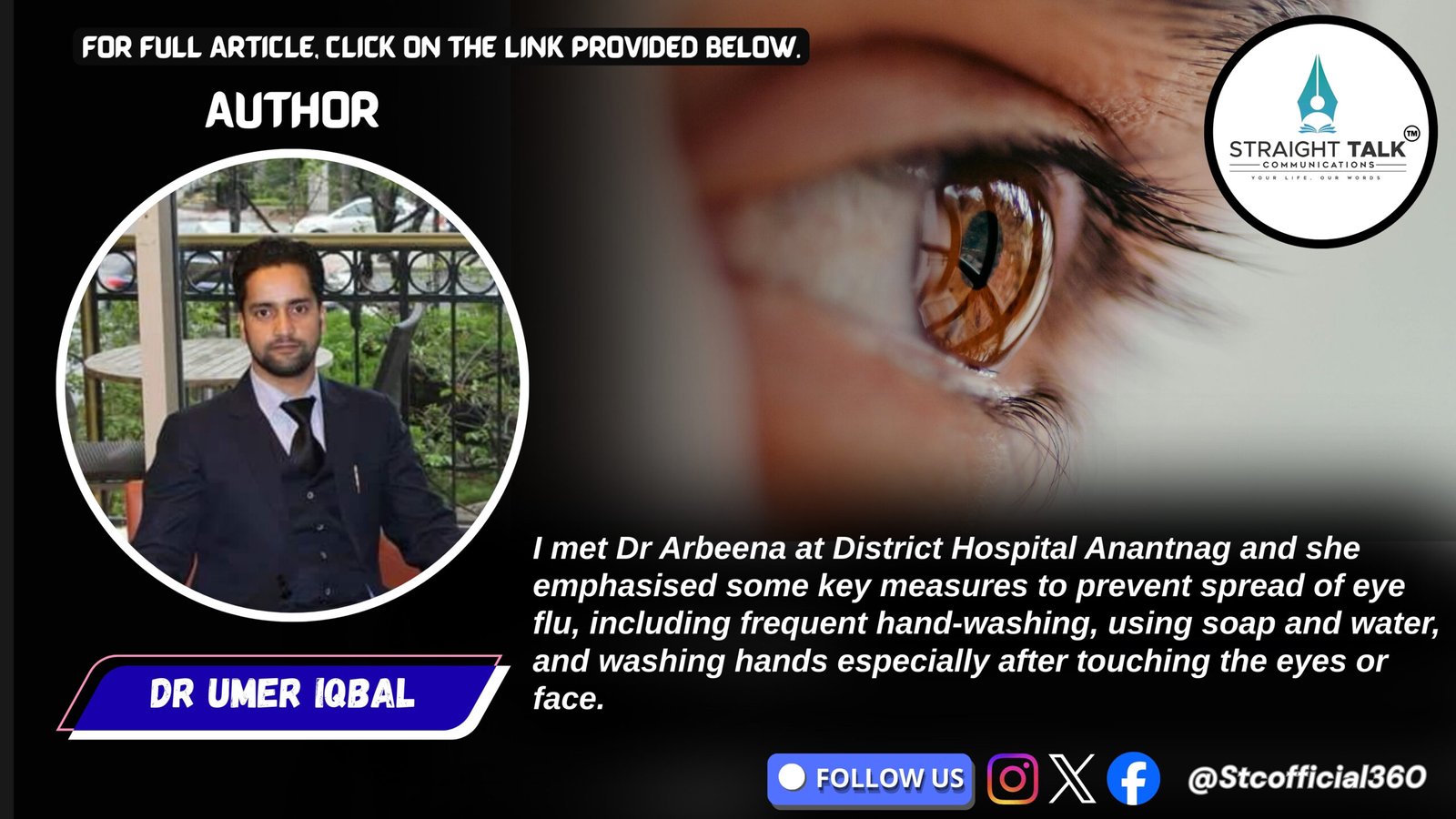Rising Eye Flu Cases in Kashmir

Dr Umer Iqbal
Kashmir is currently witnessing a surge in conjunctivitis cases, colloquially called “eye flu”, with hospitals reporting n-number of infections across the Valley. Patients are presenting with symptoms of redness, irritation, swelling of eyelids, itching, and discharge. Doctors say most cases are self-limiting, meaning they resolve on their own over about one to two weeks, provided proper care and hygiene are maintained.
The humid, damp conditions associated with the monsoon season are helping the causative agents, usually viruses or bacteria, to spread more rapidly.
In medical terms, conjunctivitis is inflammation of the conjunctiva, the clear, thin membrane that lines the inside of the eyelid and covers the white of the eye. It can have several causes viz Viral (often adenoviruses), most common form; very contagious. Bacterial, may produce more thick or purulent discharge; also contagious. And the third one vizAllergic or irritant, caused by allergens or irritants, not contagious.
The Symptoms typically include redness of the eye(s), tearing or watery discharge, sometimes thick or sticky (especially in bacterial type), Itching, burning, or gritty sensation, swelling of eyelids, light sensitivity in more severe cases. Usually one eye is affected first, after which the other may become involved. The course depends on cause: viral forms can last longer and are often worse in the beginning.
I met Dr Arbeena at District Hospital Anantnag and she emphasised some key measures to prevent spread of eye flu, including frequent hand-washing, using soap and water, and washing hands especially after touching the eyes or face.Avoid sharing towels or washcloths. If someone is infected, their personal towels or face cloths should not be used by others. No sharing of personal items, eye drops, cosmetics, pillows, etc. These are common preventive recommendations in outbreaks of infectious conjunctivitis.
Moreover, she recommended while washing hands frequently, for at least 20 seconds, with soap and warm water. Use hand sanitiser (with at least 60 % alcohol) if soap is not available.Disinfect frequently touched surfaces (doorknobs, faucets, counters). If you have symptoms, limit touching or rubbing your eyes. Use clean items for eye care (e.g. clean cotton pads, clean tissues). Launder bedding, pillowcases, towels regularly. Wear protective eyewear, if possible, when in crowded places (to avoid splashes or close contact). Use prescribed eye drops or ointments as directed if bacterial causes are diagnosed. Viral causes have fewer specific treatments, but symptoms can be relieved with lubricating (artificial tear) drops, cold/warm compresses. If symptoms worsen, severe pain, blurred vision, sensitivity to light, pus discharge, or if no improvement after 24-48 hours, consult an ophthalmologist.
The Don’ts which one should follow viz not to share towels, pillows, washcloths, eye drops, or makeup with an affected person. Do not rub your eyes, even if itching, rubbing increases irritation and risk of spread. Do not wear contact lenses until eyes fully recover (especially soft lenses). Avoid crowded places or close physical contact if you’re symptomatic. Do not ignore symptoms that get worse or don’t improve, especially if you find symptoms like vision changes or intense eye pain.
Conjunctivitis is highly contagious in its infectious forms (viral or bacterial). Even if symptoms lessen, one can still spread the infection until discharge or tearing reduces.Because many people in rural or densely populated areas share facilities, the risk of transmission is higher. Early hygiene habits can drastically reduce spread, especially in families, schools, and among caregivers. It typically resolves within 14-28 days for mild viral forms; bacterial types may respond to antibiotic drops within a few days after starting treatment.
The current spike in eye flu cases in Kashmir demands attentive public health behaviour: good hygiene, avoiding sharing personal items, and seeking medical advice when needed. While most cases will resolve without serious complications, preventive care is essential to prevent spread and avoid more severe eye problems.
The author is editor Straight Talk Communications. He can be mailed at editor@straight-talk-communications.com







